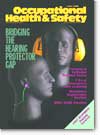
June 2004
Cover Story
By Eric Miller
DOES anyone know the NRR of a pinky finger? Hearing protectors have evolved a great deal from their early days. Innovation has been driven by performance measures. Manufacturers have continued to raise the bar in levels of comfort, softness, attenuation levels, ease of use, and convenience.
Features
By Frank J. Poliafico, RN
AFTER nearly a dozen years of clinical, academic, and administrative work in the then-young EMS System, in the early 1980s, I ventured "outside the box" of "traditional" EMS (albeit, only 10 years old at that point) and began to teach initial emergency care to non-emergency care clinicians as a full-time venture.
By Mike Kimberley
WITH more than 25 percent of all workplace accidents involving hand and finger injuries (and each disabling hand injury costing as much as $26,000), many companies and organizations are placing a higher priority on identifying the critical issues associated with the workplace environment.
By Jennifer Juergens
WHEN a major distributor of tires and wheels wanted to put together a safety incentive program, the call went out to Chip Separk, president and CEO of Recognition Solutions in Raleigh, N.C., who partners with Chicago-based Hinda Incentives. CS Recognition was already doing the service award program for the company.
By George Sloan
YOU can increase productivity and reduce downtime in your plant by applying a systematic facility identification program. If you think this is an expensive proposition, the alternative--downtime, errors, and injuries--can be much more costly. You realize cost benefits through a reduction in process and production errors and fewer lost time accidents.
By Jerry Laws
Occupational Health & Safety subscribers who answered an e-mailed survey earlier this year indicated they have used and planned to repeat safety incentive programs within a year. They also reported excellent results, which ranged from enthusiastic employees to measurable accident reductions, zero OSHA recordables, and a 60 percent reduction in auto accidents claims, in one case.
By Barry R. Weissman
WHAT do a police officer approaching a suspicious looking person and a quality control technician inspecting an integrated circuit board have in common? They both need good visual acuity.
By Nancy Kalaora
BREAKING down language barriers is critical to maintaining a safe work environment. Why the concern? As the number of employees with English as a Second Language (ESL) has increased over the past decade, the number of workplace injuries has risen disproportionately.
By Bill Sims Jr.
AS a safety manager, you have probably spent enough time in the trenches to see the ill effects of poorly designed safety incentive programs. I'm speaking of programs that merely reward employees for reaching an injury-free milestones without changing underlying employee behavior.
By Dina Schultz
LIKE everyone, you're probably looking to reduce workplace injuries, and you think a safety program focusing on attitude may be your ticket to injury-free employees. You may very well be right. But you may be surprised to find that the journey toward an injury-free workplace may be just as important as the final outcome.
By Brian Bennett
THE terrorist threat is all too real. Terrorists can choose from a wide variety of attacks to execute against this country, including kidnapping, murder, cyber, product adulteration, or use of weapons of mass destruction (biological, nuclear, incendiary, chemical, or explosive agents).
By Judy L. Fitch, Ph.D., Barry E. Fitch, MBA, DPT, IOC
BACK injuries represent a problem of epidemic proportions in the United States and are among the most common and costly musculoskeletal disorders experienced. According to the Bureau of Labor Statistics, 400,000 people have back injuries on the job each year (www.bls.gov, 2000).
By Griff Hughes
RECENT studies by two sheet metal manufacturers placed the cost of a single hand injury requiring stitches at $22,000 and $30,000, respectively. T
By Jerry Laws
TWO high-rise building evacuations last year focused building owners and city officials nationwide on the issues of adequate signage and evacuation systems. Thousands of workers and diplomats successfully found their way out of the United Nations headquarters in Manhattan during the massive Aug. 14 electrical blackout.
By Craig Miller
WORKER's compensation rates and litigation, OSHA fines, productivity losses, and other fallout from workplace illness and accidents keep employers searching for the most effective ways to involve employees in safety programs. A recent survey reveals one method of improving employee performance that is quickly gaining in popularity is the use of online incentive programs.
Departments
By Ronnie Rittenberry
According to the latest Liberty Mutual Workplace Safety Index, employee injuries are costing U.S. businesses almost $1 billion each week, an amount that's up from recent years even after adjusting for inflation in medical and wage benefits.
By John Strelecky
IF you walk around a Walt Disney World resort or theme park, you are likely to witness something that in most other settings would seem bizarre.
By Jerry Laws
IF you and your family travel by car this summer, be sure to watch out for work zones. And keep this tidbit in mind: There's about a one-in-four chance each tractor-trailer you encounter has a problem that would cause an inspector to order it out of service.